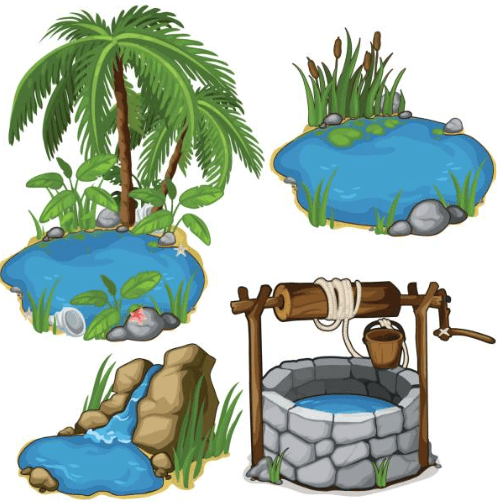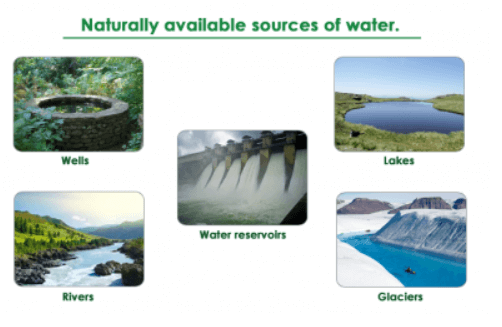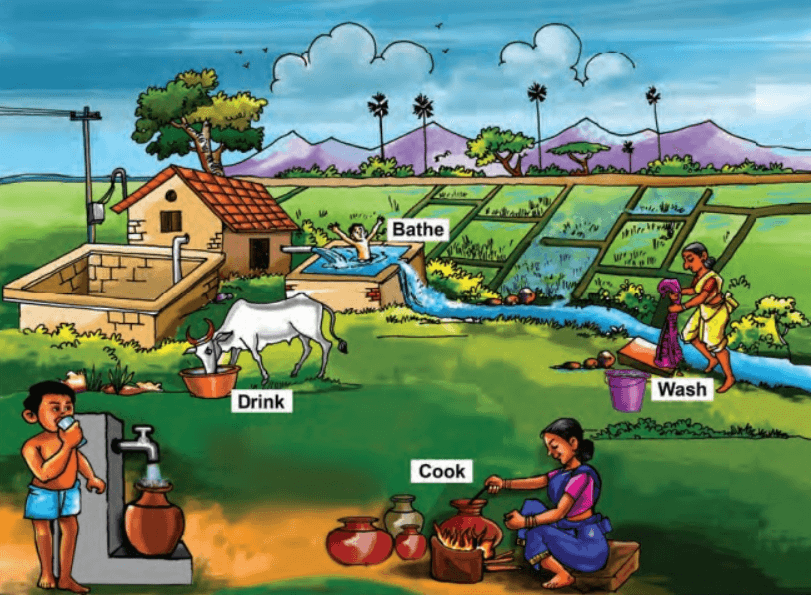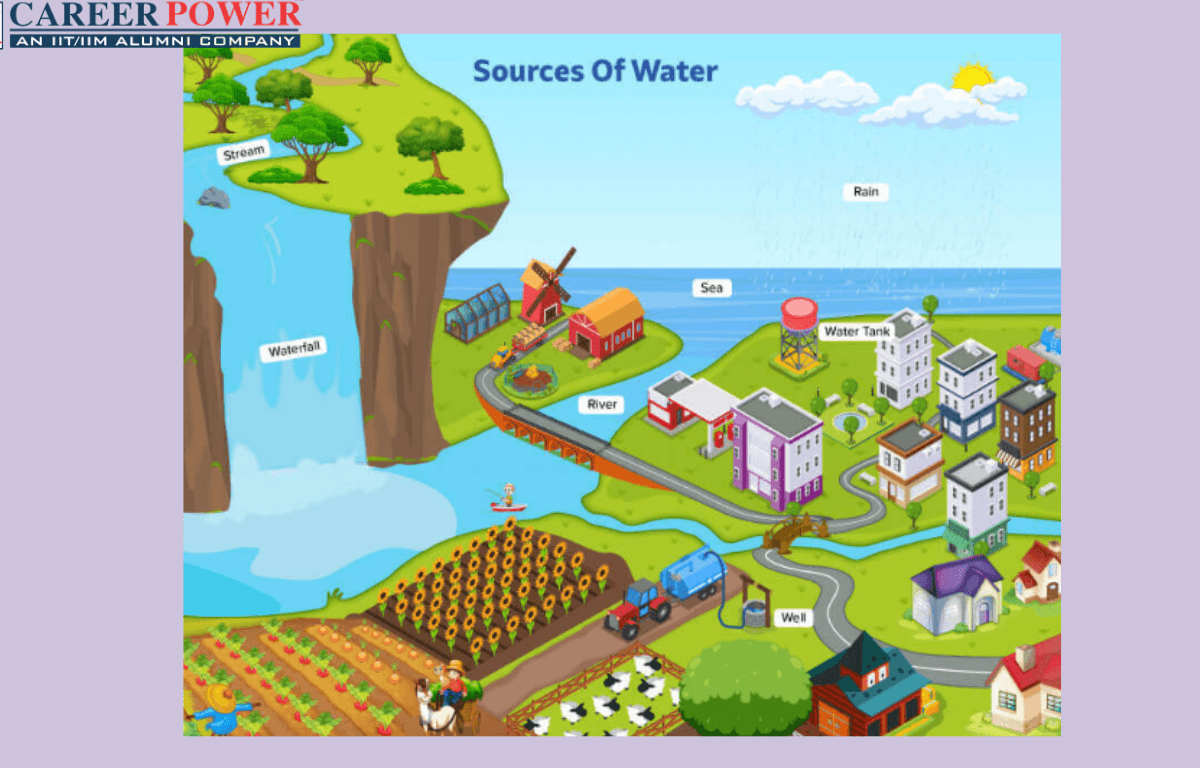Water is a vital substance for life on Earth. It’s a colorless, odorless, and tasteless liquid made up of two hydrogen atoms and one oxygen atom (H2O). Water is essential for various biological processes, and it covers 71% of the Earth’s surface in the form of oceans, rivers, lakes, and more. Water can exist in three main states: Solid (ice), Liquid (water), and Gas (water vapor).
These states depend on the temperature and pressure conditions. For example, water freezes into ice at or below 0 degrees Celsius (32 degrees Fahrenheit) and turns into steam at 100 degrees Celsius (212 degrees Fahrenheit) under standard atmospheric pressure. Water plays a crucial role in supporting ecosystems, regulating climate, and sustaining human life.
Water
For now, we know that water is a remarkable substance with unique properties that make it crucial for the survival and well-being of life on our planet. Water is also known as a “Universal Solvent”. It is a key component of biological processes, serves as a solvent for biochemical reactions, and helps regulate temperature in organisms. Now, let us discuss some more information about water.

- Universal Solvent: Water is often called the “Universal Solvent” because it has the ability to dissolve a wide range of substances. This property makes it crucial for chemical reactions in living organisms and various industrial processes.
- Density Anomaly: Unlike most substances, water’s density decreases as it freezes into ice. This property allows ice to float on water, which is important for aquatic life as it insulates the water below and allows life to thrive in cold environments.
- Hydrogen Bonding: Water molecules are attracted to each other due to hydrogen bonding. This gives water its unique properties like surface tension, high specific heat, and cohesion.
- Water Scarcity: Despite the abundance of water on Earth, many regions suffer from water scarcity, where access to clean and safe drinking water is limited. This is a pressing global issue affecting millions of people.
- Water Conservation: Due to growing concerns about water scarcity and environmental stability, efforts to conserve water through efficient usage and responsible management have become increasingly important.
Sources of Water Meaning
The sources of water refer to the origin or location from which water is obtained. Common sources of water include rivers, lakes, reservoirs, groundwater wells, rainwater, and desalination of seawater provides readily accessible freshwater for drinking, irrigation, and industrial processes. Additionally, natural springs and mountain glaciers are important sources of pristine fresh water. Safeguarding and managing these water sources is crucial for ensuring a sustainable and secure water supply for communities around the world.

List of Water Sources
These sources support ecosystems, agriculture, industry, and human needs. We have listed 10 different sources of water below:
- Rainwater
- Rivers and Streams
- Lakes and Ponds
- Seas and Ocams
- Wells
- Dams and Reservoirs
- Canals
- Tanks and Water Storage System
- Waterfalls
- Atmospheric Water Vapors
Sources of Water with Description
Here we have discussed some of the sources of water. Each of these sources has its advantages and challenges, and the choice of source often depends on geographic location, local water availability, and the intended use of the water. Sustainable water management and conservation are crucial to ensuring a stable and reliable supply of freshwater from reliable supply of freshwater from these sources.
| Different Sources of Water | ||
| Water Source | Description | Common Uses |
| Surface Water Sources | Water bodies like rivers, lakes, and reservoirs. | Drinking. irrigation, industry, and recreation. |
| Ground Water Sources | It is the water stored below the Earth’s surface in aquifers, accessed through wells. | Rural and urban water supplies. |
| Rainwater | Precipitation is collected and stored for various purposes. | Irrigation, toilet flushing, and drinking (when treated). |
| Desalination | Conversion of seawater into freshwater using processes like reverse osmosis. | Coastal regions with water scarcity. |
| Natural Springs | Naturally occurring sources of freshwater flow from underground aquifers to the surface. | Drinking, agriculture, and local supplies. |
| Glaciers | Glaciers are vast stores of freshwater in solid form found in mountain and polar regions. | Contributes to rivers and lakes. |
| Atmospheric Water | Extraction of water vapor from the air, condensing it into liquid form for use. | Emerging technology in humid areas. |
| Recycled/Reclaimed Water | Treated wastewater is reused for non-potable purposes. | Irrigation, industrial processes, and cooling. |
Surface Water Sources:
These include rivers, lakes, and reservoirs. Surface water is readily accessible and often used for drinking, irrigation, industrial processes, and generational activities. It’s replenished by rainfall and runoff.
Ground Water Sources:
Groundwater is found beneath the Earth’s surface in aquifers, which are layers of water-bearing rock or sediment. It’s accessed through wells and is essential for both rural and urban water supplies. Groundwater is a relatively stable source, but over-extraction can lead to depletion.
Rainwater:
Rainwater harvesting involves collecting and storing rainwater for various uses. It’s particularly valuable in regions with irregular rainfall patterns or limited access to conservation water sources. Rainwater can be used for irrigation, toilet flushing, and even drinking when properly treated.
Desalination:
In coastal regions, desalination plants are used to convert seawater into freshwater through processes like reverse osmosis. This technology is critical in arid areas where freshwater sources are scarce, but it can be energy-intensive and costly.
Natural Sources of Water
Now, let us discuss some common Natural Sources of water. These natural sources of water are essential for ecosystems, human survival, and various human activities. They are replenished through the natural Water cycle, making them vital resources for communities and ecosystems alike.

- Rivers: Flowing bodies of freshwater that usually originate from mountains or highlands and eventually discharge into larger bodies of water, such as seas or oceans.
- Lakes: Large bodies of standing freshwater formed through various geological processes, often fed by rivers or springs and drained by an outlet.
- Rainwater: Precipitation in the form of rain that falls directly from the atmosphere and can be collected for various uses.
- Glaciers: Massive stores of freshwater in the form of ice, typically found in polar regions and mountainous areas, which slowly release water as they melt.
- Groundwater: Water stored beneath the Earth’s surface in aquifers, which are geological formations that can hold and transmit water.
Uses of Water
Water is a vital resource with a wide range of uses in various aspects of life. Here we have discussed a few examples of the uses of water in our daily lives and in various industries. Ensuring access to clean and sustainable water sources is crucial for human well-being and the health of our planet.

- Drinking and Hydration: Safe drinking water is essential for human survival and maintaining health.
- Sanitation: Water is used for flushing toilets, maintaining hygiene, and ensuring proper sanitation in households and public facilities.
- Irrigation: Water is crucial for agriculture, providing the necessary hydration for crops to grow.
- Industrial Processes: Many industries require water for cooling, cleaning, and as a component in manufacturing processes.
- Energy Production: Water is used in power plants, both for cooling in thermal power plants and as a source of energy in hydroelectric power generation.
- Firefighting: Water is used by firefighters to extinguish fire and protect lives and property.
- Cooking and Food Preparation: Water is used in various cooking processes, from boiling to steaming and washing food items.
Importance of Sources of Water
Sources of water are crucial for sustaining life and ecosystems. Here we have discussed some of the points that highlight the importance of sources of water.
- Life Support: Water sources are fundamental for human survival, providing the necessary water for drinking, cooking, and maintaining hygiene.
- Agriculture: Essential for irrigation, water sources, agriculture, ensuring the growth of crops and food production.
- Ecosystems: Water sources serve as habitats for diverse species, contributing to biodiversity and maintaining ecological balance.
- Industries: Various industries rely on water for manufacturing processes, energy production, and cooling systems.
- Recreation: Water bodies offer recreational opportunities, from swimming and boating to fishing, contributing to human well-being.
- Climate Regulation: Oceans play a crucial role in regulating the Earth’s climate through processes like evaporation and precipitation.
- Transportation: Waterways serve as important channels for the transportation of goods, fostering economic activities.
- Scenic Beauty: Lakes, rivers, and oceans contribute to the aesthetic appeal of landscapes, supporting tourism and leisure.
- Renewable Energy: Hydropower from rivers and dams is a significant source of renewable energy, contributing to sustainable power generation
For more details, you can also go through our article on the Water Cycle.



 50 Vegetables Name for Kids in English a...
50 Vegetables Name for Kids in English a...
 Food Chain: Definition, Types, Examples,...
Food Chain: Definition, Types, Examples,...
 Human Respiratory System: Definition, Di...
Human Respiratory System: Definition, Di...













